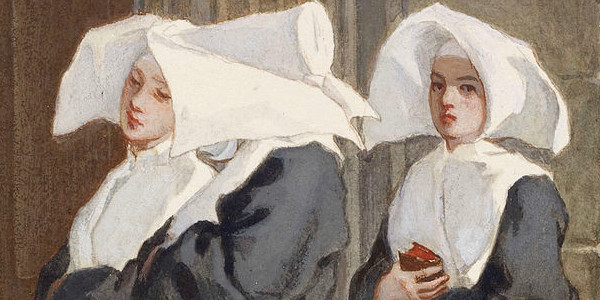
by Armand Gautier via Wikimedia Commons
When I was about six years old my father took me on an errand and we stopped for lunch. The waitress looked at me and then said to my father, “She’s your image.” A big smile spread across his face, and I can still recall how he beamed when he later told my mother about this.
Parents take delight in seeing their image in their children. Hebrews 3:1 says about Jesus: “He is the reflection of God’s glory and the exact imprint of God’s very being.” The Greek word for “imprint” is charakter. It means an exact representation, almost like a seal or mark branded into something. Jesus is the very image of the Father, who takes delight in him: “This is my beloved Son, in whom I am well pleased” (Lk 3:22).
You may recall hearing that the sacrament of Baptism gives us a character. It’s sometimes described as an indelible mark on the soul. But since the soul is spiritual and can’t be literally marked, what does that mean? It’s a way of saying that Baptism makes us like Jesus. It imprints his likeness on us. The character configures us to Jesus in a way that enables us to take part in Christian worship.
These ideas give us a link to the Year of Consecrated Life that the Church is celebrating in 2015. All the baptized are consecrated by their baptism. They all have character. They are all configured to Christ and are called to holiness. Then what is the consecrated life? It is a special consecration rooted in baptism, but one that configures the person to Christ in a different manner.
When Jesus came on earth, he lived as the Son of the Father in a radical way. He lived a radical poverty in complete dependence on the Father, a radical chastity in giving up marriage for the sake of the Kingdom, and a radical obedience in always doing the will of his Father: “My food is to do the will of him who sent me and to complete his work” (Jn 4:34). Jesus lived this way of life as the Son of the Father, in union with the Holy Spirit.
Those in the consecrated life strive to imitate Jesus by living in a way that reflects as closely as it can his own way of life: chaste, poor, and obedient. By their vows, consecrated persons make present that way of life. As Vatican II said in Lumen Gentium, through them “The Church thus portrays Christ in contemplation on the mountain, in his proclamation of the kingdom of God to the multitudes, in his healing of the sick and maimed, in his work of converting sinners to a better life, in his solicitude for youth and his goodness to all, always obedient to the will of the Father who sent him” (no 46).
This Year of Consecrated Life is not meant only for those who live it formally. Hopefully all of the baptized will take it as an incentive to grow in their own Christian life. While they don’t take vows binding themselves to a more literal following of Christ, all the baptized are called to live in the spirit of poverty, chastity, and obedience. What would that look like?
• No to consumerism, yes to a simple lifestyle, mindful of sharing with the poor.
• No to all forms of sexual indulgence, yes to the virtue of chaste and holy love.
• No to sin, yes to entrusting ourselves to God’s loving care for our lives.
By doing these things, we offer our whole lives to God. “Like living stones . . . offer spiritual sacrifices acceptable to God through Jesus Christ” (1 Peter 2:5). We will gradually come to resemble Jesus more and more.
 Sr. Marianne Lorraine Trouvé, FSP is a Daughter of St. Paul who currently works on the editorial staff of Pauline Books and Media. She has a master’s degree in theology from the University of Dayton, with a concentration in Marian studies (The Marian Research Institute at UD). She has also edited several books on Theology of the Body, including the new translation of Pope John Paul’s talks that was done by Michael Waldstein. She is also very interested in Saint Thomas Aquinas and has been working her way through the Summa for several years now, one article at a time. Besides prayer and work, she likes to write, garden, do logic puzzles and take walks with friends. She blogs at Thomas for Today.
Sr. Marianne Lorraine Trouvé, FSP is a Daughter of St. Paul who currently works on the editorial staff of Pauline Books and Media. She has a master’s degree in theology from the University of Dayton, with a concentration in Marian studies (The Marian Research Institute at UD). She has also edited several books on Theology of the Body, including the new translation of Pope John Paul’s talks that was done by Michael Waldstein. She is also very interested in Saint Thomas Aquinas and has been working her way through the Summa for several years now, one article at a time. Besides prayer and work, she likes to write, garden, do logic puzzles and take walks with friends. She blogs at Thomas for Today.












